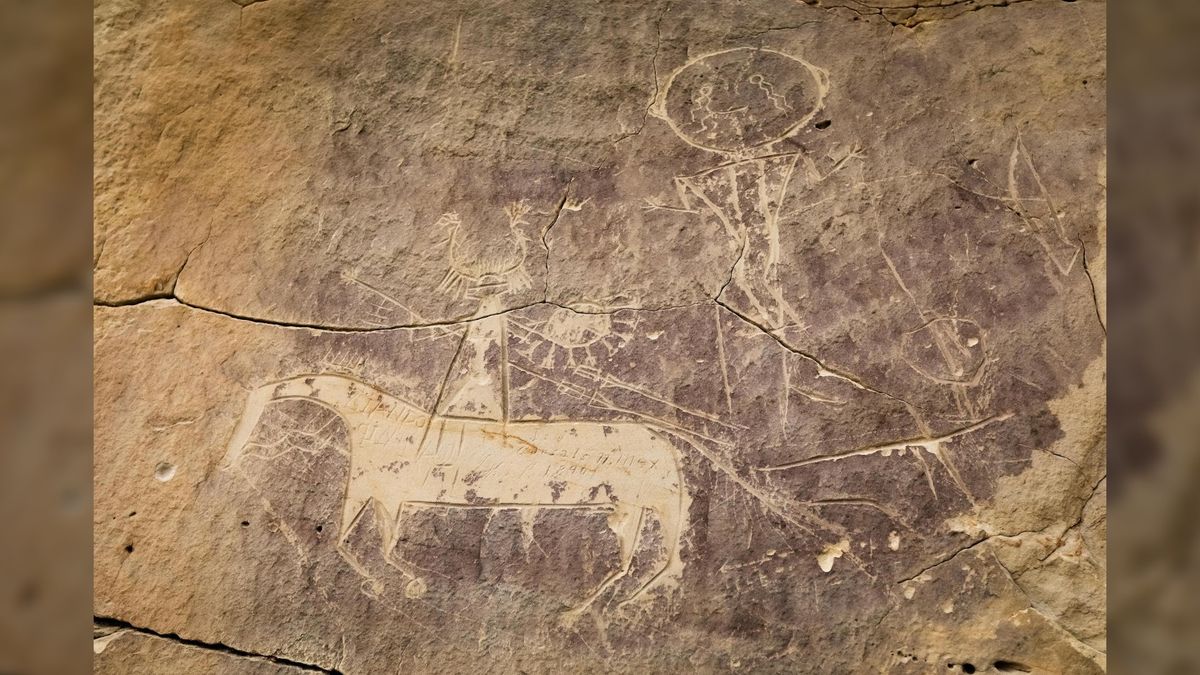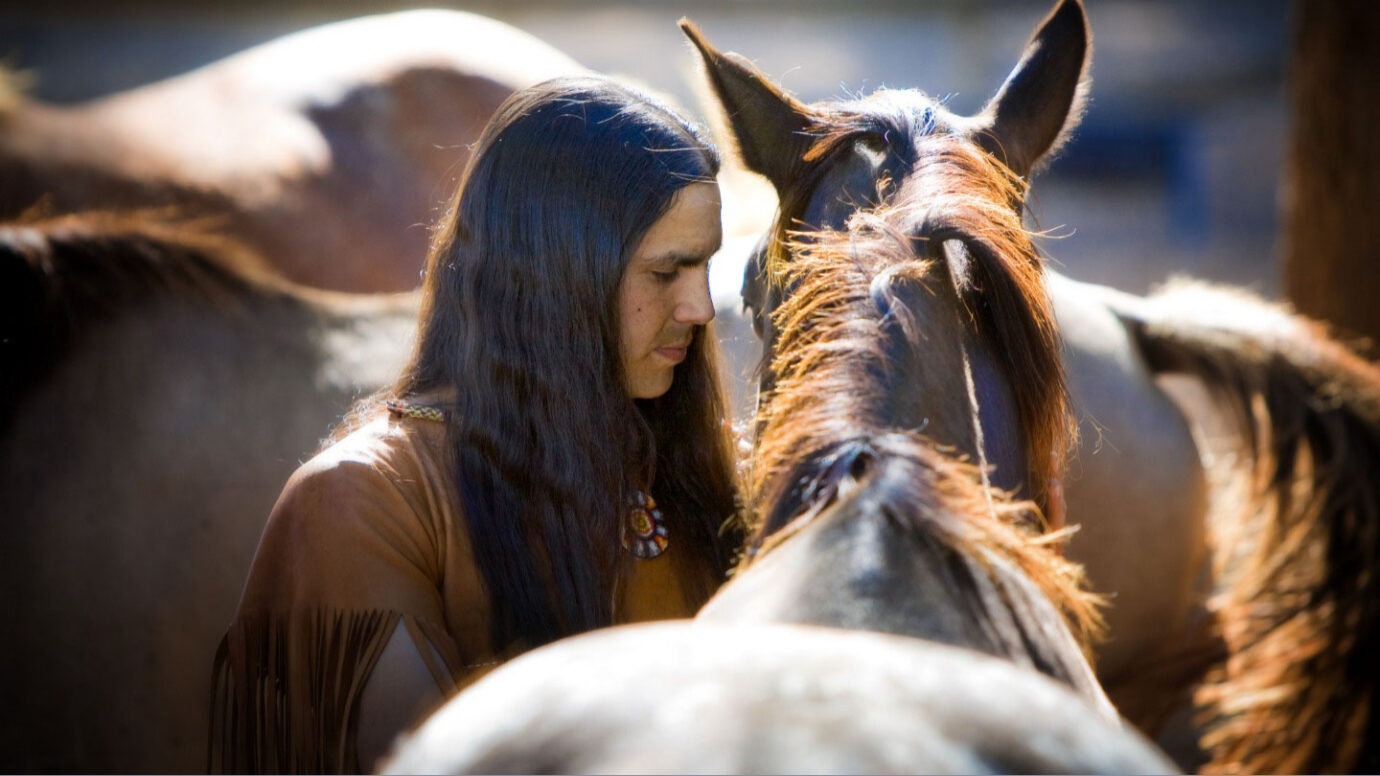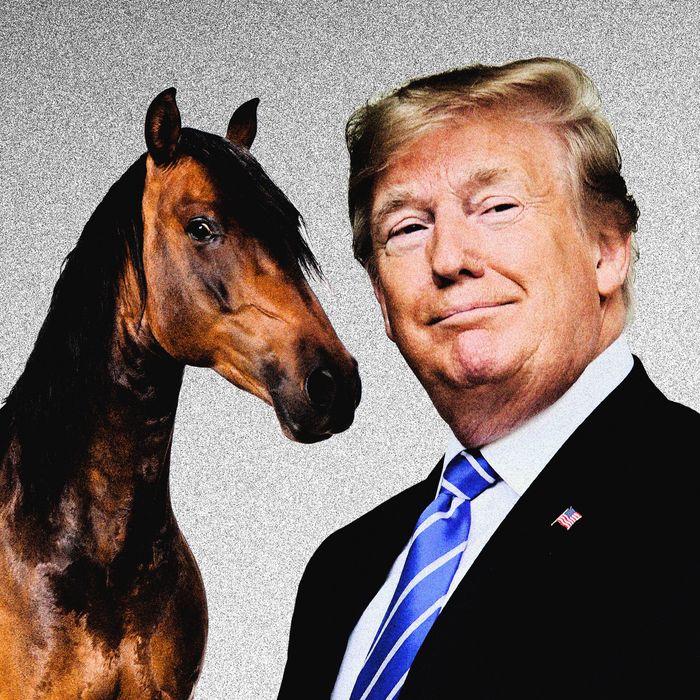Anthropology
Related: About this forumIndigenous people of the American West used 'sacred' horses a half-century earlier than previously t
Indigenous people of the American West used 'sacred' horses a half-century earlier than previously thoughtBy Kristina Killgrove published 1 day ago
Indigenous oral histories and archaeological evidence are rewriting the story of how horses came to the American West.

A petroglyph of a horse and rider, likely created by the ancestral Comanche or Shoshone people. This carving was found at the Tolar site in Sweetwater County, Wyoming.
A petroglyph carved into a grey-brown stone depicts a horse and rider (Image credit: Pat Doak)
Centuries-old horse skeletons from the American Southwest are helping rewrite a colonial myth: When the Spanish colonized the region in the 17th century, they didn't introduce horses to Indigenous people, as long thought. Instead, horses were present in the Southwest long before Europeans, and were traded by Indigenous people who formed close, sacred relationships with them, a new study finds.
Horses lived in North America for millions of years but went extinct at the end of the last ice age, about 11,000 years ago. When Europeans reintroduced horses to what is now the eastern U.S. in 1519, these hoofed mammals radically altered Indigenous ways of life, rapidly causing changes to food production methods, transportation and warfare. In the Southwest, historical Spanish records suggest horses spread throughout the area after the Pueblo Revolt in 1680, when Indigenous people forced Spanish settlers out of what is now New Mexico. But these records, made a century after the revolt, do not align with the oral histories of the Comanche and Shoshone people, who document horse use far earlier.
Using tools such as radiocarbon dating, ancient and modern DNA analysis and isotope analysis (isotopes are elements with varying numbers of neutrons in their nuclei), a large and diverse team of researchers from 15 countries and multiple Native American groups, including members of the Lakota, Comanche and Pawnee nations, have now determined that horses did indeed spread across the continent earlier and faster than previously assumed.
In a research paper published Thursday (March 30) in Science, the researchers detailed how they tracked down 33 horse specimens from archaeological collections across the U.S. in order to reconstruct Indigenous human-horse relationships. "The horses that are the focus of our study are those from definitively Indigenous contexts in the Southwest and the Great Plains," study co-author William Taylor, an archaeologist at the University of Colorado Boulder, told Live Science in an email.
More:
https://www.livescience.com/indigenous-people-of-the-american-west-used-sacred-horses-a-half-century-earlier-than-previously-thought
Bayard
(28,161 posts)This is very exciting! ![]()
It stands these kinds of assumptions on their head:
"The horses seen in the American West today are descended from a domesticated breed introduced from Europe, and are therefore a non-native species and not indigenous."
And ranchers can no longer claim mustangs are an invasive species infringing on their cattle grazing of public lands, and should be eliminated.
![]()
Duppers
(28,457 posts)The key is educating the dense lawmakers & we need lobbyists to stay on their heels.
Ways to help Wild Horses, PLEASE click:
https://americanwildhorsecampaign.org/other-ways-help-wild-horses
Kali
(56,548 posts)and the current populations are from all kinds of ancestry.
Bayard
(28,161 posts)The first horses on this continent did not arrive from Europe--they were already here. Horses actually developed here as a species, then spread to other parts of the world.
There are now many, many authoritative articles on the subject.
Here's one excerpt from an article in the American Museum of Natural History:
"By 55 million years ago, the first members of the horse family, the dog-sized Hyracotherium, were scampering through the forests that covered North America. For more than half their history, most horses remained small, forest browsers. But changing climate conditions allowed grasslands to expand, and about 20 million years ago, many new species rapidly evolved. Some--but not all--became larger and had the familiar hooves and grazing diets that we associate with horses today. Only these species survived to the present, but in the past, small and large species lived side by side."
sl8
(16,957 posts)The new information is that after they'd gone extinct in North America, they were reintroduced almost 50 years earlier than previously thought.
Kali
(56,548 posts)the only thing new is finding the Native American adaptation to using horses was a 100 or so years earlier than previously thought. still Spanish stock from Europe, just arriving from east sooner rather than from south.
jeffreyi
(2,489 posts)And crossed the Bering Strait a long, long time ago. There is a documentary called "True Appaloosa" about this.
Judi Lynn
(164,038 posts)DNA and skeletal clues rewrite the tale of how horses came to the Great Plains by the 1600s
An image of a Native American man standing next to a brown horse while other brown horses mill in the background.

A collaboration between Western scientists and Native Americans finds that Indigenous groups rapidly incorporated horses of Spanish ancestry into Great Plains cultures by the early 1600s. Some Indigenous oral histories say their relationship with horses goes back even farther to possible equine survivors of the Ice Age.
SACRED WAY SANCTUARY
By Bruce Bower
MARCH 30, 2023 AT 2:00 PM
Indigenous knowledge and Western science have written a new tale about when horses most recently arrived in North America.
Spaniards brought horses to Mexico in 1519. Indigenous peoples then took the reins, rapidly transporting offspring of those equine newcomers north along trade routes. As a result, a new study finds, many Native American populations across the Great Plains and the Rockies had incorporated horses into their ways of life by the early 1600s, decades before encountering any Europeans.
This unconventional scenario of how domesticated horses originally spread throughout central and western North America bucks a previous narrative: European written accounts dating mainly to the 1700s and 1800s had contended that horses first spread into North America in large numbers after Pueblo people temporarily drove Spanish settlers out of New Mexico in 1680. But little evidence existed to confirm or deny that claim.
Europeans’ historical texts didn’t ring true for molecular archaeologist Yvette Running Horse Collin of the Center for Anthropobiology and Genomics of Toulouse in France. Running Horse Collin is a member of the Oglala Lakota Nation. Great Plains populations such as the Lakota and Comanche speak of having cared for, herded and otherwise interacted with horses long before Europeans showed up.
Running Horse Collin contacted Toulouse colleague Ludovic Orlando, a molecular archaeologist who has traced the origins of domesticated horses to southwestern Asia more than 4,200 years ago (SN: 10/20/21). The duo organized a large collaboration of Western scientists and Indigenous scholars and officials, including members of the Lakota, Comanche, Pawnee and Pueblo Nations.
More:
https://www.sciencenews.org/article/native-americans-spanish-horses



